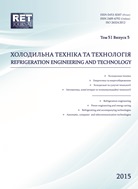OPTIMAL SYSNTHESIS PROCESSES OF LOW-TEMPERATURE CONDENSATION ASSOCIATED OIL GAS PLANT REFRIGERATION SYSTEM
DOI:
https://doi.org/10.15673/0453-8307.5/2015.44793Keywords:
propane/ethane, refrigerant mixture, exergy losses, centrifugal compressor, refrigerant concentration, refrigerant fractionation, pinch analysis, low-temperature condensationAbstract
Design of modern high-efficient systems is a key priority for the Energy Sector of Ukraine. The cooling technological streams of gas and oil refineries, including air coolers, water cooling and refrigeration systems for specific refrigerants are the objectives of the present study. Improvement of the refrigeration unit with refrigerant separation into fractions is mandatory in order to increase cooling capacity, lowering the boiling point of coolant and increasing the coefficient of target hydrocarbons extraction from the associated gas flow. In this paper it is shown that cooling temperature plays significant role in low-temperature condensation process. Two operation modes for refrigeration unit were proposed: permanent, in which the concentration of the refrigerant mixture does not change and dynamic, in which the concentration of refrigerant mixtures depends on the ambient temperature. Based on the analysis of exergy losses the optimal concentration of refrigerant mixtures propane/ethane for both modes of operation of the refrigeration unit has been determined. On the basis of the conducted pinch-analysis the modification of refrigeration unit with refrigerant separation into fractions was developed. Additional recuperative heat exchangers for utilization heat were added to the scheme. Several important measures to increase the mass flow rate of refrigerant through the second section of the refrigeration centrifugal compressor from 22.5 to 25 kg/s without violating the agreed operational mode of the compressor sections were implemented.References
Lynch J.T., Wilkinson J.D., Hudson H.M., and Pitman R. N. 2003, Process Retrofits Maximize the Value of Existing NGL and LPG Recovery Plants, Ortloff Engineers, Ltd. 82-nd convention of Gas Processors Association, SA, Texas, 10 p.
Le-Gall A., Laflotte B. 2005, Compare the different options for NGL recovery from natural gas, Gas processing department, Technip, Gastech, 21 p.
Kemp I. C. 2007, Pinch analysis and process integration IChemE, UK, 396 p.
Feng X., Zhu XX. 1995, Combining pinch and exergy analysis for process modifications Applied Thermal Engineering. 17(1): P.250-260.
Khmelniuk M., Ostapenko A., Yakovleva O., 2013. Low-temperature condensation refrigeration unit energy efficiency after applying of a hydrocarbon mixture as a working fluid in a propane refrigeration installation. "Compressors 2013", Papiernicka. 6 p.
Ataei A. Chang K.Y. 2010, Combined pinch and exergy analysis for energy efficiency optimization in a steam power plant International Journal of the Physical Sciences. 5(7), 1110-1123 p.
Ostapenko O., Yakovleva O., Khmelniuk M. 2013 Improvement of the refrigeration installation of the associated petroleum gas low-temperature condensation complex, Journal of Industrial Gases, 6 (2013), 23-28 p.
Martynyuk M.O., Khmelniuk M.G. 2009 Analysis of characteristics of propane refrigerating compressor such as type «TP5-5» at its work on a mixture propane/ethane Journal of Industrial Gases No 4. 23-28 p.
Kwak HY. 2003, Exergic and thermoeconomic analysis of power plant Energy, No 28, 343-360 p. 10. Smith R. 2005, Chemical Process Design and Integration, John Wiley & Sons Ltd, UK 714 p.


